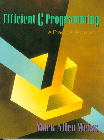 |
Advanced Programming
Spring 2005
Recitation 5: Pointers and Arrays
Week 5: Feb 15-17
Due (on time): 2005-02-22 23:59:59
Due (late): 2005-02-27 23:59:59
|
CS 2213/2211 Advanced Programming Spring 2005 Recitation 5: Pointers and Arrays Week 5: Feb 15-17 Due (on time): 2005-02-22 23:59:59 Due (late): 2005-02-27 23:59:59 |
Recitation 5 should be submitted
following directions at: submissions with deadlines
|
For this recitation you must:
int main(int argc, char **argv);
as we will discuss shortly. As for the occurrence of argv[1], convert this the same way you would convert a simple reference to a[1] in an array declared int a[5]. You should each figure out how to do this on your own, without help from other students.]
|
Contents of email submission
for Recitation 1: Last Name, First Name; Course Number; Recitation Number. a. Source listing for the rewritten program bubblesort.c. b. Three runs of this program with 100, 1000, and 10000 on the command line. You should print the array only for the first run of size 100. c. Give the expected "Big-Oh" performance of a bubblesort algorithm, and show that the results of the three runs above are consistent with this performance. (This gives how fast the algorithm is expected to run as a function of the size of the data being processed -- in this case an array of size n.)
|